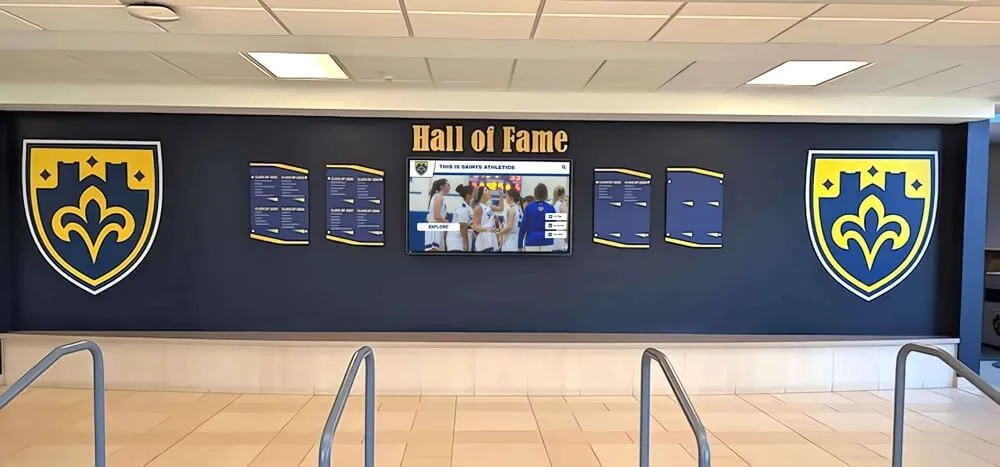From Static Plaques to Dynamic Digital Recognition
Walk into most schools, universities, or community organizations and you'll find walls lined with plaques—bronze nameplates honoring donors, engraved panels recognizing alumni achievements, commemorative tiles celebrating milestones. These traditional recognition walls represent years of institutional history and countless contributions, yet they face mounting challenges: limited space forcing difficult choices about whose recognition gets removed, maintenance costs that compound annually, and static presentations that fail to engage modern audiences accustomed to interactive digital experiences.
The solution? Digitizing your plaque wall transforms physical recognition into dynamic, interactive displays that honor every achievement without space constraints while creating engaging experiences that inspire visitors and strengthen institutional culture. Rather than choosing between preserving legacy plaques or making room for new recognition, digital solutions enable comprehensive inclusion where all contributors receive appropriate honor regardless of when their recognition was earned.
Today’s digital plaque wall solutions combine high-resolution touchscreen displays, cloud-based content management, multimedia storytelling capabilities, and web accessibility to create recognition experiences impossible with traditional physical plaques. Organizations implementing these systems discover they can finally showcase complete recognition histories, update information instantly without costly engraving, incorporate photos and videos that bring achievements to life, and extend access beyond physical walls to remote stakeholders worldwide.
At Rocket Alumni Solutions, we’ve helped hundreds of schools and organizations successfully digitize their plaque walls, preserving institutional legacy while creating modern recognition programs aligned with how people engage with information today. This comprehensive guide explores why digitizing plaque walls makes strategic sense, proven implementation methodologies, technology considerations, and best practices ensuring successful outcomes.
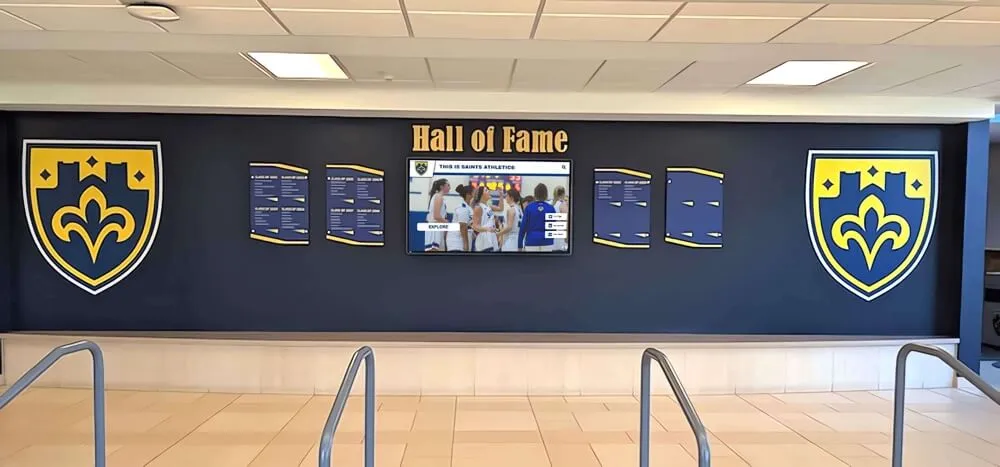
Traditional plaque walls create beautiful displays but face space limitations and maintenance challenges that digital solutions eliminate
Why Schools and Organizations Are Digitizing Plaque Walls
The momentum toward plaque wall digitization reflects converging pressures that make traditional physical approaches increasingly problematic while digital alternatives deliver compelling advantages.
Space Limitations Create Recognition Inequity
Physical plaque walls have fixed capacity. Whether 20 feet of corridor wall or dedicated recognition rooms, space eventually fills completely. This mathematical reality forces impossible decisions:
Which achievements get removed to make room for new recognition? Schools face painful choices between honoring historic donors who established programs decades ago versus recognizing current contributors sustaining operations today. Alumni associations must decide whether plaques commemorating 1960s achievements should stay or make room for recent graduates’ accomplishments.
Who receives recognition when capacity constraints prevent comprehensive inclusion? Organizations establishing minimum gift thresholds to manage plaque wall space effectively tell smaller contributors their support matters less. Athletic programs limiting hall of fame induction to preserve available spots inadvertently devalue worthy achievements that don’t make arbitrary cutoffs.
How do you maintain equitable visibility when prime locations fill first? Early plaques occupy prominent positions while later additions get relegated to less visible edges or overflow locations. This creates hierarchies where recognition prominence depends more on timing than achievement significance.
Digital plaque walls eliminate these constraints entirely. A single touchscreen display can showcase unlimited recognition—hundreds or thousands of honorees—with each receiving equivalent presentation quality and search accessibility. Space becomes infinite rather than scarce, enabling truly comprehensive recognition that honors all who meet established criteria rather than only those who fit available wall space.
Maintenance and Update Costs Compound Over Time
Physical plaques require ongoing investment beyond initial fabrication:
Engraving updates when information changes prove expensive. Correcting misspelled names, updating deceased honorees’ life dates, or revising biographical details requires complete plaque replacement at $150-$400 each. Organizations often leave outdated information uncorrected simply because update costs are prohibitive.
Physical deterioration demands restoration work. Bronze plaques tarnish and oxidize. Engraved plastic fades when exposed to sunlight. Mounting hardware loosens as buildings settle. Acrylic covers scratch and yellow over time. Regular maintenance and periodic refurbishment add recurring expenses that digital systems avoid entirely.
Installation modifications accommodate layout changes. Adding plaques to existing walls requires drilling new mounting holes, patching around removed plaques, and ensuring aesthetic consistency across different installation periods. Facility renovations often require complete plaque wall relocation at substantial cost.
Administrative labor for tracking, ordering, installing, and maintaining physical plaques consumes staff time that could focus on mission-critical activities. Most organizations underestimate the cumulative hours spent managing physical recognition programs when calculating total costs.
Digital systems replace these ongoing expenses with one-time hardware investment and manageable annual software subscriptions. Content updates requiring expensive engraving changes happen through simple online forms taking minutes rather than weeks. This cost structure makes comprehensive recognition financially sustainable even for organizations with constrained budgets.
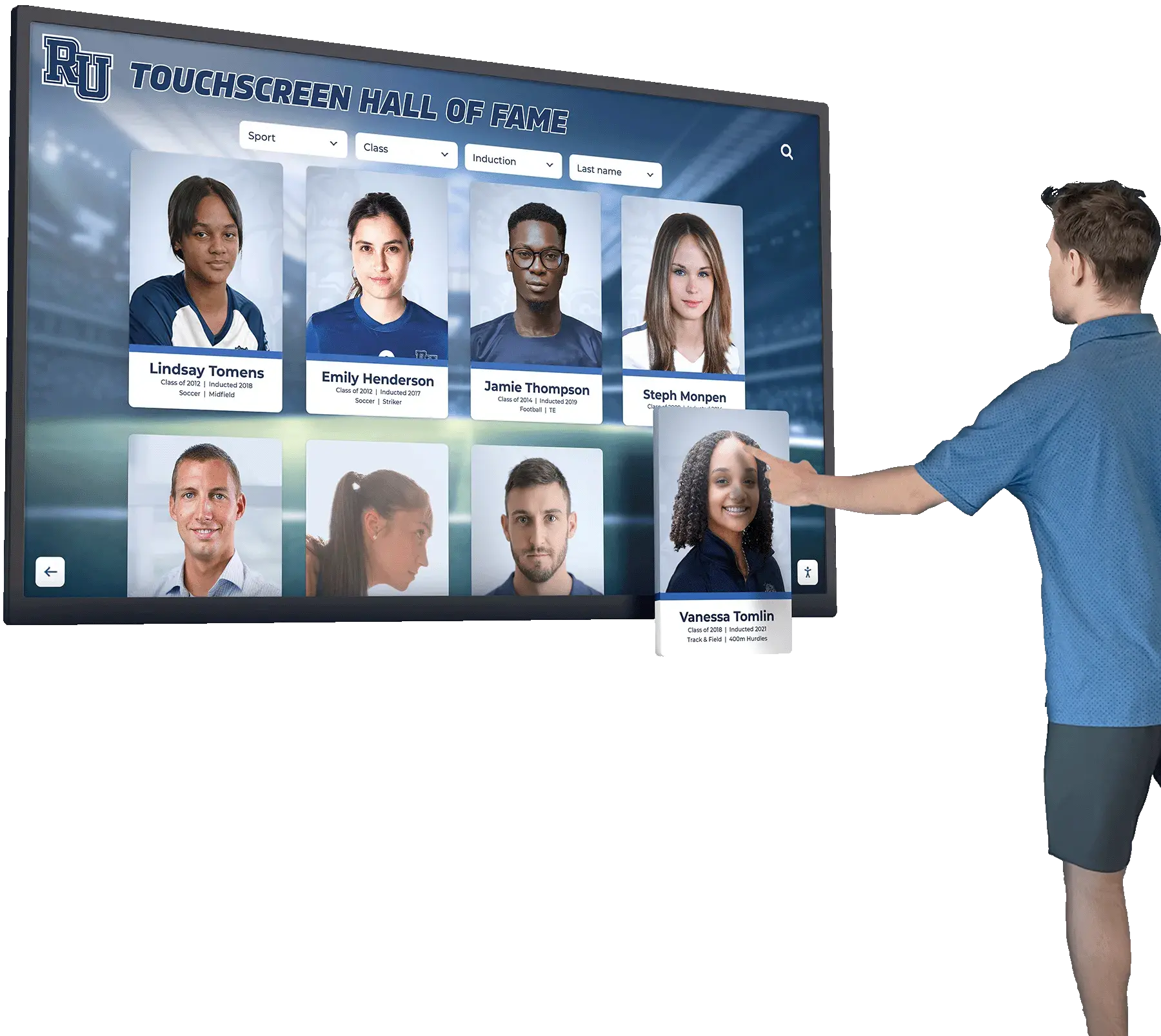
Interactive digital displays transform passive plaque reading into engaging exploration that visitors actively enjoy
Limited Information Capacity Restricts Meaningful Recognition
Traditional plaques accommodate perhaps 50-100 words—enough for names, dates, and basic facts but insufficient for meaningful recognition that celebrates complete contributions.
Donor plaques typically list names, gift amounts, and years. This minimal information acknowledges contributions financially but fails to recognize motivations, capture personal connections to institutions, explain gift impacts, or preserve donor stories that inspire future giving.
Alumni recognition reduces lifetime achievements to graduation years and perhaps career titles. Visitors learn someone graduated in 1985 and became a physician but discover nothing about their specific accomplishments, community contributions, leadership roles, or paths from campus to career success.
Memorial plaques commemorate lives with birth and death dates plus perhaps a brief quote. Families seeking lasting tributes find these minimal acknowledgments inadequate for capturing personalities, celebrating passions, or preserving memories that help loved ones live on in institutional consciousness.
Historic milestone markers note event dates and basic descriptions without providing rich context explaining significance, describing participants, capturing atmosphere, or connecting moments to broader institutional narratives.
Digital plaque walls transform recognition from basic facts into comprehensive tributes through:
- Detailed biographical narratives providing depth that honors complete contributions rather than reducing people to name listings
- Photo galleries showing honorees across different life stages, creating personal connections impossible with static text
- Video testimonials capturing voices, personalities, and personal reflections in formats that resonate emotionally
- Historical documentation including original correspondence, newspaper coverage, or archival materials that preserve complete stories
- Impact descriptions explaining how contributions made lasting differences, inspiring current community members through evidence of collective achievement
This multimedia richness ensures recognition truly celebrates individuals rather than simply documenting their existence.
Static Presentations Fail to Engage Modern Audiences
People today expect interactive, personalized experiences. Physical plaque walls remain fundamentally passive—visitors can only read what’s engraved, following predetermined sequences dictated by physical arrangement rather than their own interests.
Search limitations make finding specific recognition challenging. Locating a particular name among hundreds of plaques requires systematically reading each one. Visitors interested in specific graduation years, geographic regions, or achievement types cannot filter presentations to match their interests.
Engagement metrics show visitors typically spend 30-60 seconds glancing at traditional plaque walls before moving on. This brief interaction barely registers compared to 5-10 minutes commonly spent with digital displays offering interactive exploration, suggesting significantly deeper engagement when recognition becomes exploratory rather than passive.
Accessibility barriers prevent many from engaging with physical plaques. Visitors with vision impairments cannot access engraved text lacking screen reader compatibility. Wheelchair users find high-mounted plaques difficult to read. Non-English speakers encounter recognition they cannot understand without translation capabilities.
Remote access impossibility limits engagement to people who can physically visit. Alumni living across the country or internationally cannot view their recognition. Families researching deceased relatives’ contributions find information unavailable without in-person visits. Prospective donors evaluating institutional recognition quality cannot preview experiences before committing support.
Interactive touchscreen recognition displays address all these limitations through intuitive search interfaces, personalized exploration pathways, universal design accommodating diverse needs, and web-based platforms extending access globally.
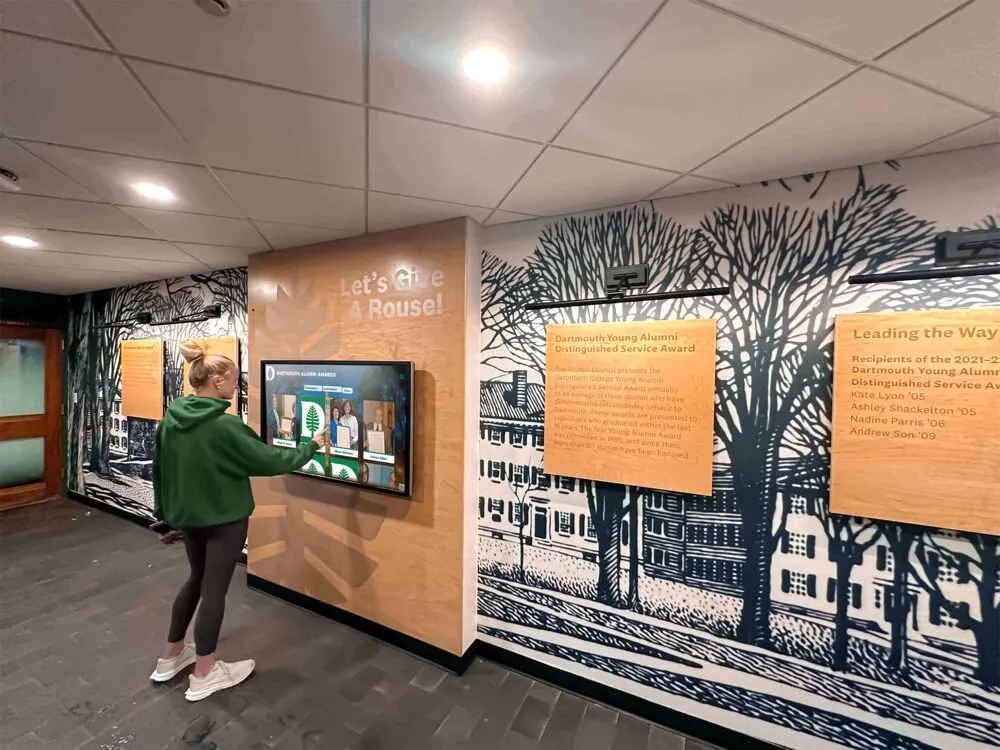
Strategic placement in high-traffic areas ensures maximum visibility and engagement with digital recognition programs
Comprehensive Benefits of Digitizing Your Plaque Wall
Organizations transitioning from traditional plaques to digital systems experience transformative advantages across multiple dimensions.
Unlimited Recognition Capacity Without Space Constraints
The most immediate advantage is infinite capacity. Digital plaque walls can accommodate:
Thousands of honorees with comprehensive profiles rather than basic name listings. Schools can recognize every donor regardless of contribution size, honor all athletic letter winners across decades of program history, celebrate every academic achievement, and commemorate all historic milestones without ever running out of space.
Complete institutional history preserved in accessible formats. Rather than storage boxes full of removed plaques representing out-of-sight recognition, digital archives maintain permanent, searchable records ensuring no contribution gets forgotten regardless of when it occurred.
Multiple recognition categories organized intuitively. Single displays can house donor recognition, alumni achievements, athletic honors, historic milestones, memorial tributes, and community partnership acknowledgments—all accessible through clear category navigation rather than requiring separate physical locations for each recognition type.
Growing collections accommodated automatically. As organizations add new recognition annually, digital capacity expands effortlessly. No construction projects, wall space negotiations, or display redesigns necessary—simply add content through online management systems.
This unlimited capacity enables truly comprehensive recognition philosophies where every qualifying contribution receives appropriate honor rather than only those fitting arbitrary space limitations.
Instant Updates Without Costly Fabrication Delays
Digital management transforms update processes from multi-week fabrication cycles costing hundreds per change into instant modifications taking minutes at zero marginal cost.
Information corrections happen immediately. Discovering a misspelled name, incorrect date, or outdated biographical detail no longer requires expensive plaque replacement—simply edit the content through cloud-based management systems and changes appear instantly across all display locations and web platforms.
Deceased honoree updates adding death dates, memorial messages, or expanded life reflections occur quickly without plaque replacement costs. Families appreciate timely acknowledgment of loved ones’ passing reflected promptly in memorial recognition.
Achievement additions for living honorees happen as accomplishments occur. Alumni earning advanced degrees, receiving honors, or achieving career milestones can see their recognition profiles updated immediately to reflect ongoing success, creating living recognition that grows alongside individuals rather than freezing achievements at initial induction moments.
Biographical enhancements incorporating new information discovered through research, family submissions, or archival discoveries improve recognition quality over time. Physical plaques remain forever static, but digital recognition becomes richer as more information becomes available.
Seasonal features highlighting relevant recognition at appropriate times—honoring veterans during November, recognizing mothers around Mother’s Day, celebrating founding benefactors on institutional anniversaries—create dynamic experiences connecting recognition to current institutional life.
Organizations implementing digital recognition display strategies report this update flexibility proves among the most valuable system capabilities, enabling recognition programs that remain accurate, current, and responsive to stakeholder needs.
Rich Multimedia Storytelling That Honors Complete Contributions
Digital plaque walls transform recognition from basic text into comprehensive tributes incorporating multiple media formats:
Photo galleries showing honorees at different life stages create personal connections. Seeing someone as a young student, mid-career professional, and distinguished elder provides human context that single engraved names never convey. For memorial recognition, multiple photos help preserve complete life representations beyond single formal portraits.
Video testimonials capture personalities in ways text cannot match. Hearing honorees describe their institutional experiences, explain what motivated contributions, or share advice for current community members creates emotional resonance far beyond reading biographical text.
Audio recordings preserve voices, campus songs, historic speeches, or oral history interviews. These audio elements add sensory dimensions to recognition that engage visitors through multiple channels rather than relying solely on visual text consumption.
Interactive timelines place individual recognition within broader institutional narratives. Viewers can see how specific contributions connected to facility developments, program launches, or organizational milestones, understanding individual achievements as parts of collective institutional stories.
Document archives including original correspondence, historical photographs, newspaper clippings, or archival records provide authentic artifacts enriching recognition with primary source materials. Digitizing these supporting documents makes them accessible rather than remaining in archives only researchers can access.
Social media integration for living honorees can display recent posts, professional updates, or community engagement, showing how relationships with institutions continue beyond initial recognition moments. This dynamic element keeps recognition feeling current rather than frozen in past.
This multimedia richness ensures digital recognition truly celebrates complete contributions rather than reducing people to anonymous name listings on bronze plates.
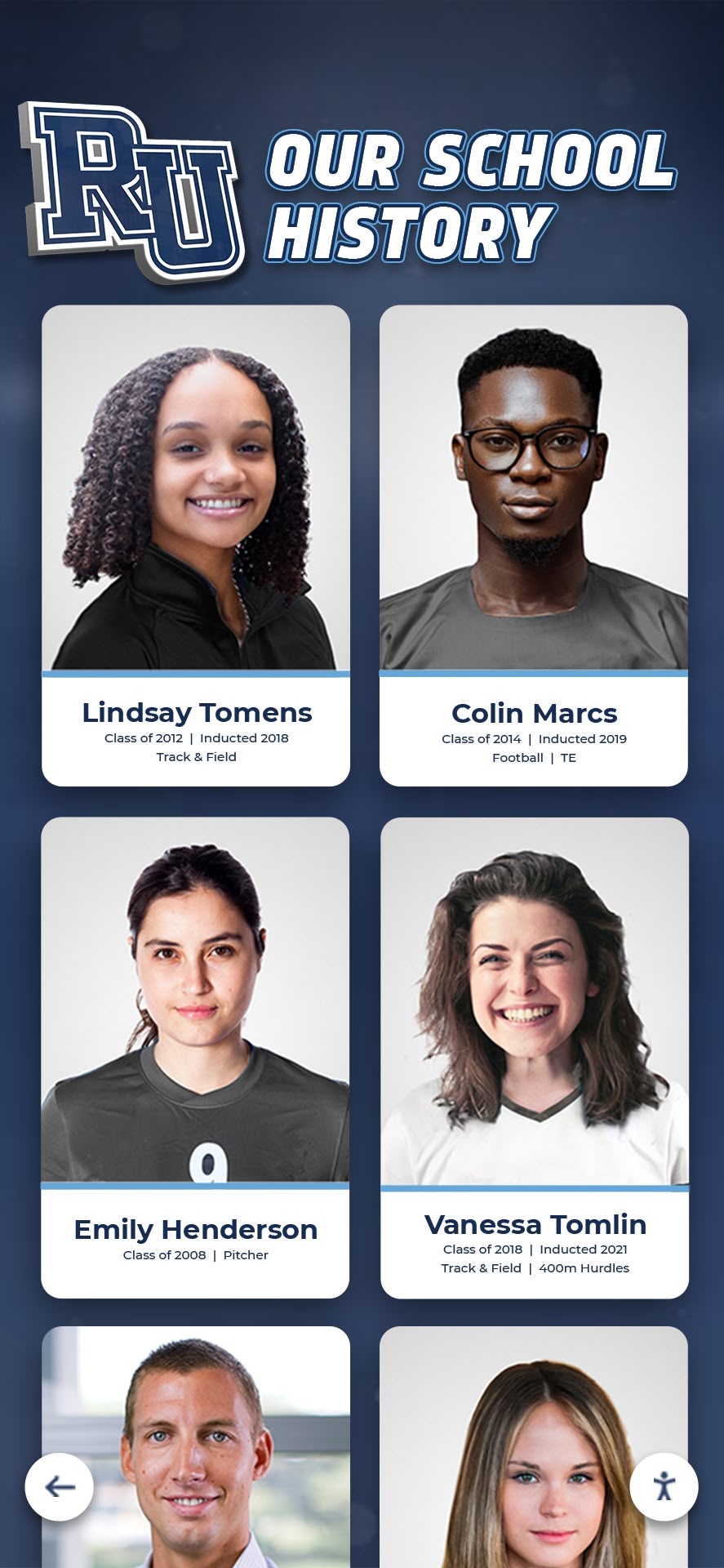
Comprehensive digital profiles preserve complete achievement stories rather than reducing accomplishments to basic name listings
Powerful Search and Discovery Capabilities
Interactive digital systems provide discovery tools impossible with physical plaques:
Name searches enable instant location of specific individuals. Visitors can find their own recognition, locate family members’ contributions, or discover friends’ achievements immediately rather than reading hundreds of plaques sequentially hoping to encounter desired names.
Filter capabilities support exploration by multiple criteria:
- Graduation years or service periods
- Recognition categories (donors, athletes, scholars, volunteers)
- Geographic origins or current locations
- Professional fields or industries
- Achievement types or award levels
- Specific time periods or institutional eras
Keyword searches find recognition based on any text in profiles—mentions of specific programs, facility names, cities, companies, or other terms appearing in biographical narratives. This comprehensive text search reveals connections physical plaque arrangements never expose.
Relationship mapping can highlight connections between honorees. Systems might show alumni who played on the same teams, graduated the same years, worked for common companies, or share other connections. These relationship discoveries create engagement beyond individual profile viewing.
Recommended content algorithms suggest related recognition based on viewing patterns. Someone exploring 1990s basketball athletes might receive recommendations for coaches from that era or athletes from other sports during the same period, encouraging extended exploration.
These discovery capabilities transform recognition from passive plaque reading into active exploration where visitors create personalized journeys through institutional history based on their unique interests.
Web Accessibility Extends Reach Beyond Physical Walls
Modern digital plaque systems typically include web-based platforms complementing physical touchscreen installations:
Remote viewing enables anyone with internet access to explore recognition from anywhere. Alumni living across the country or internationally can view their plaques, show spouses and children their recognition, and maintain connections to institutions without traveling to campus.
Social sharing functionality encourages honorees to distribute their recognition through personal social media networks. Each shared profile extends institutional visibility to hundreds of connections while celebrating individual achievements, creating organic promotion generating significantly more reach than traditional plaques ever achieve.
Alumni engagement tools integrated with interactive digital recognition programs enable graduates to update their own profiles with career news, submit photos, or provide additional biographical information. This participatory approach strengthens ongoing relationships while improving recognition content quality through community contributions.
Recruitment support for prospective students, donors, or volunteers. Web-based recognition allows institutions to share achievement evidence with audiences evaluating involvement decisions. Prospective donors can see recognition quality before committing support. Student-athletes considering programs can explore comprehensive athletic achievement histories.
Memorial accessibility proves especially meaningful for families of deceased honorees living far from physical recognition locations. Web access enables families to visit digital memorials whenever they need connection with lost loved ones, providing comfort not limited by geographic distance or facility operating hours.
Search engine visibility means recognition profiles can appear in web searches for honorees’ names, extending discovery beyond people who intentionally seek institutional recognition. This discoverability creates unexpected connections when people searching for individuals discover institutional relationships through indexed recognition content.
Organizations implementing comprehensive web-based recognition platforms typically see web traffic to recognition content exceed physical display engagement by factors of 10x or more, demonstrating how digital accessibility dramatically expands program reach.
Planning Your Plaque Wall Digitization Project
Successful digitization requires systematic planning addressing content, technology, budget, and stakeholder considerations.
Content Audit and Digitization Strategy
Begin by comprehensively documenting your existing recognition program:
Complete inventory of all current plaques including:
- Exact text from each plaque
- High-quality photographs documenting current appearance
- Physical condition assessments
- Installation locations and dates
- Fabrication details (materials, suppliers, costs)
- Any available background information about honorees
Historical research uncovering additional information about recognized individuals:
- Archival materials (correspondence, newspaper coverage, institutional records)
- Yearbook and alumni magazine content
- Biographical databases and published obituaries
- Family interviews and information submissions
- Professional accomplishments and career trajectories
- Community contributions and volunteer service
Supplementary photography beyond plaque documentation:
- Portrait photographs from various life stages
- Event photos showing honorees at ceremonies or institutional activities
- Historic images of campus/facilities during their involvement periods
- Family photos provided by relatives (for memorial recognition)
- Professional headshots showing current appearances (for living honorees)
Organizational framework establishing how recognition will be categorized digitally:
- Primary categories (donors, alumni, athletics, academics, memorials)
- Sub-categories within primary groupings
- Cross-referencing when individuals qualify for multiple categories
- Tagging strategies enabling multi-dimensional discovery
- Search optimization ensuring all content remains discoverable
Content enhancement priorities identifying which recognition deserves expanded documentation:
- Major benefactors warranting comprehensive tribute development
- Historic figures significant to institutional identity
- Recent honorees for whom information remains readily available
- Memorial subjects where family engagement opportunities exist
- Categories lacking sufficient representation in current recognition
This comprehensive content audit creates clear understanding of digitization project scope while identifying opportunities for recognition enhancement beyond simply replicating existing plaque information.
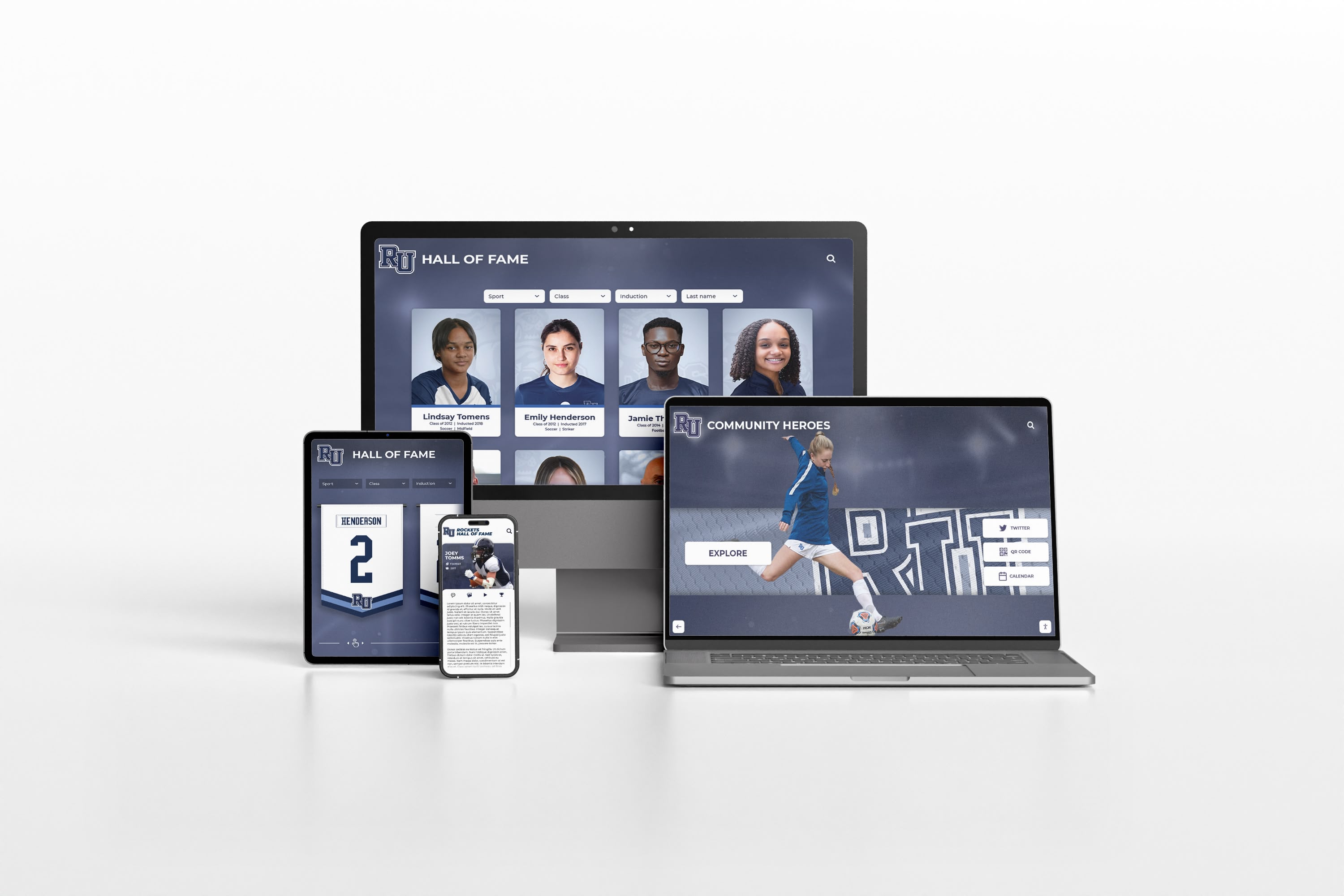
Responsive design ensures digital recognition displays properly across all device types from large touchscreens to mobile phones
Technology Platform Selection
Choose digital systems balancing functionality, usability, cost, and long-term sustainability:
Purpose-built recognition platforms designed specifically for schools and organizations:
Solutions like those from Rocket Alumni Solutions provide specialized features addressing recognition needs that general digital signage or content management systems lack. These purpose-built platforms typically include:
- Pre-designed recognition templates optimized for donor, alumni, and achievement profiles
- Intuitive content management requiring minimal technical expertise
- Robust search and filtering specifically designed for name-based discovery
- Multi-user access with role-based permissions for distributed management
- Integrated web and physical display capabilities from single content source
- Responsive design automatically adapting to different screen sizes
- Analytics dashboards showing engagement patterns and popular content
- Ongoing platform development incorporating user feedback and feature requests
- Dedicated support teams understanding recognition program contexts
General digital signage alternatives:
Organizations with existing digital signage infrastructure might consider adapting current systems for recognition displays. This approach maintains technological consistency but typically requires more customization effort and may lack recognition-specific features like advanced search, biographical templates, and stakeholder engagement tools that purpose-built platforms provide.
Custom development approaches:
Larger institutions with in-house development resources sometimes build custom recognition systems. While this enables complete control, custom development typically costs 3-5x more than commercial solutions, requires ongoing maintenance investment, and lacks the continuous improvement that commercial platforms provide through serving hundreds of organizations.
Key evaluation criteria regardless of platform choice:
- Ease of content management: Can non-technical staff easily update recognition?
- Search capabilities: Does search feel intuitive and return relevant results quickly?
- Visual presentation quality: Do profiles display in professional, dignified formats?
- Scalability: Will the system perform well with thousands of honorees?
- Mobile responsiveness: Does content display properly on phones and tablets?
- Support and training: What implementation assistance and ongoing help is available?
- Total cost of ownership: What are cumulative 5-year costs including licensing, support, and potential upgrades?
Hardware Considerations for Physical Displays
Digital plaque walls require appropriate display hardware:
Commercial-grade touchscreens designed for continuous operation:
Consumer displays intended for residential use typically fail within 12-18 months when running continuously in institutional settings. Commercial displays built for 24/7 operation cost more initially but deliver 5-7 year lifespans with significantly lower failure rates.
Size selection based on viewing distance and space constraints:
- 32-43 inch displays work well for intimate spaces where viewers stand 3-5 feet away
- 55-65 inch displays suit moderate spaces with 5-10 foot viewing distances
- 75-85 inch displays serve large lobbies where viewers might be 10-15 feet distant
- Video wall configurations combine multiple displays for expansive recognition installations
Mounting approach matching architectural contexts:
- Wall-mounted installations for corridors and lobbies with available wall space
- Freestanding kiosks for centers of rooms or spaces lacking suitable walls
- Custom millwork integration building displays into architectural elements
- Portrait or landscape orientation depending on content and space characteristics
Environmental considerations affecting hardware selection:
- Brightness levels suitable for ambient lighting conditions (avoid direct sunlight on screens)
- Protective enclosures for high-traffic areas where accidental contact might occur
- Ventilation ensuring adequate airflow preventing overheating
- Security hardware deterring theft in accessible public spaces
- Climate control in areas experiencing temperature or humidity extremes
Network infrastructure supporting content updates:
- Hardwired Ethernet connections (preferred for reliability)
- WiFi connectivity where cabling is impractical
- Backup connectivity options ensuring display functionality during network issues
- Content caching enabling offline operation if connections fail temporarily
Organizations implementing digital halls of fame installations typically work with experienced integrators understanding institutional display requirements and avoiding consumer-grade solutions that promise savings but deliver poor reliability.
Budget Planning and Financial Analysis
Develop realistic cost projections comparing traditional versus digital approaches:
Initial investment for digital system:
- Hardware (displays, computers, mounting): $8,000-$25,000 per installation location
- Software licensing: $2,000-$8,000 annually depending on platform and features
- Content development: $5,000-$20,000 for comprehensive digitization and enhancement
- Installation and configuration: $2,000-$5,000 for professional setup
- Training and launch support: $1,000-$3,000 ensuring smooth adoption
Ongoing costs for digital system:
- Annual software licensing and support: $2,000-$8,000
- Content updates and management: Primarily staff time (2-5 hours monthly)
- Periodic hardware updates: $8,000-$25,000 every 5-7 years
- Electricity for displays: $100-$300 annually per display
- Network connectivity: Often covered by existing institutional infrastructure
Comparative costs for traditional plaques (per honoree):
- Plaque fabrication: $150-$400 per plaque
- Installation labor: $50-$150 per plaque
- Ongoing maintenance and cleaning: $20-$50 annually per plaque
- Information updates requiring replacement: $150-$400 per change
- Space expansion when walls fill: $10,000-$50,000 for construction/renovation
Break-even analysis shows most organizations achieve cost parity within 3-5 years when comparing digital system investments against cumulative traditional plaque costs for ongoing recognition additions and maintenance. Organizations with 50+ new recognitions annually typically achieve break-even within 2-3 years.
Additional digital value not captured in direct cost comparisons:
- Eliminated space constraints enabling comprehensive recognition
- Enhanced engagement from interactive features and multimedia content
- Extended reach through web accessibility
- Improved stakeholder relationships from better recognition experiences
- Administrative time savings from simplified content management
Many schools and organizations find that implementing comprehensive digital recognition programs costs less long-term than continuing traditional approaches while delivering dramatically superior results across stakeholder engagement, administrative efficiency, and recognition program quality.
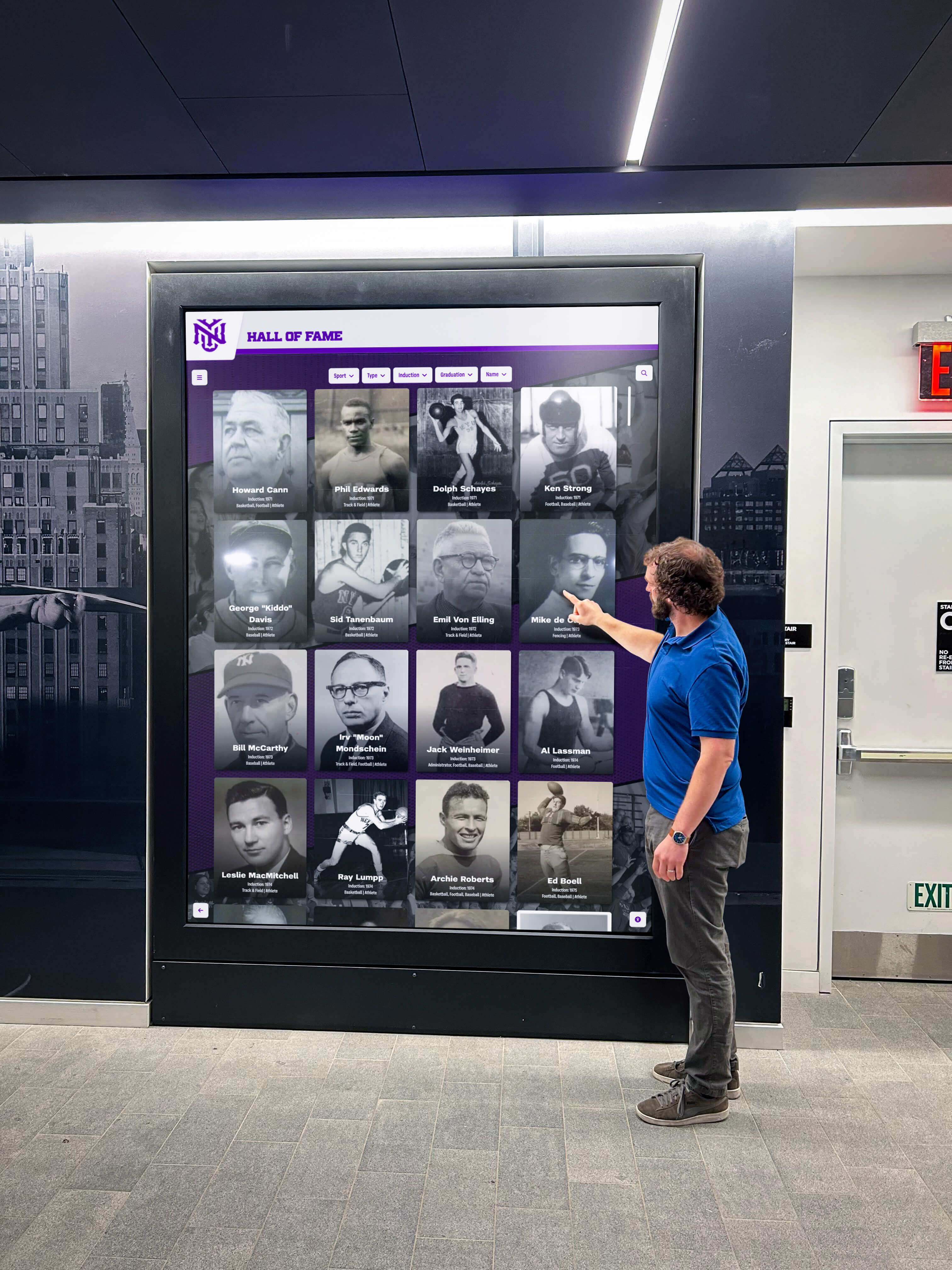
Engaged visitors exploring digital recognition spend significantly more time discovering institutional history than traditional plaques generate
Implementation Best Practices for Successful Digitization
Proven strategies ensure smooth transitions from traditional plaques to digital recognition systems.
Phased Implementation Reduces Risk and Builds Momentum
Rather than attempting complete digitization before launching access, successful programs use phased approaches:
Phase 1: Foundation and Recent Recognition (Months 1-3)
- Select and install hardware at primary location
- Configure software platform and establish organizational structure
- Digitize most recent 3-5 years of recognition (typically 50-200 profiles)
- Enhance content with photos and expanded biographies where readily available
- Launch system with focused promotion to key stakeholder groups
- Gather initial feedback informing subsequent development
This foundation phase creates working system demonstrating digitization value while establishing sustainable processes for continued expansion.
Phase 2: Comprehensive Current Era (Months 4-9)
- Systematically digitize past 10-20 years of recognition
- Expand content enhancement incorporating yearbook photos, news coverage, and available biographical information
- Implement web-based access complementing physical displays
- Develop promotional materials encouraging stakeholder engagement
- Train additional staff or volunteers on content management
- Refine user experience based on initial usage analytics
Phase 3: Historical Archives (Months 10-24)
- Work systematically through older recognition by decade or category
- Conduct deeper historical research filling information gaps
- Engage alumni and family members soliciting photos and stories
- Create special features highlighting milestone anniversaries or significant eras
- Expand distribution with additional display locations if warranted
- Establish ongoing maintenance rhythms ensuring long-term currency
Phase 4: Sustainable Operations (Year 2+)
- Rapid recognition of new honorees as they’re added (1-2 week turnaround)
- Regular content enhancement improving existing profiles
- Community contribution integration from stakeholder submissions
- Periodic platform improvements adopting new features and capabilities
- Continued promotion maintaining awareness across stakeholder populations
- Assessment and optimization based on accumulated engagement data
This phased approach enables earlier launches building excitement and demonstrating value rather than delaying benefits until achieving complete historical coverage that might take years.
Content Quality Standards Ensure Appropriate Recognition
Establish guidelines ensuring consistent, professional, and dignified recognition:
Written content standards:
- Minimum biographical length (200-300 words for standard profiles)
- Enhanced profiles for major contributors (500-1,000+ words)
- Tone and voice guidelines maintaining appropriate formality
- Fact-checking protocols verifying information accuracy
- Attribution requirements for quoted material or specific claims
- Inclusive language ensuring respectful recognition across diverse populations
Visual content requirements:
- Minimum image resolution (300 DPI for print, 72 DPI minimum for screens)
- Preferred image orientations and aspect ratios
- Acceptable photo subjects and appropriate imagery
- Photo rights and permissions documentation
- Professional editing standards (cropping, exposure, color correction)
- File naming conventions and organizational structure
Multimedia guidelines:
- Video length recommendations (2-5 minutes typical)
- Audio quality standards ensuring clear comprehension
- Captioning requirements for accessibility
- Content appropriateness ensuring dignified recognition
- Technical specifications (formats, resolutions, file sizes)
Consistency frameworks:
- Template usage ensuring visual uniformity across recognition categories
- Information field standards (which biographical elements should be included)
- Categorization and tagging conventions
- Cross-referencing protocols when individuals qualify for multiple categories
- Update procedures maintaining accuracy over time
These quality standards ensure digital recognition maintains professionalism and dignity appropriate for honoring meaningful contributions rather than appearing hastily assembled or inconsistent.
Stakeholder Communication Ensures Smooth Transitions
Successful digitization requires clear communication with multiple stakeholder groups:
Current honorees and families:
- Advance notice explaining digitization plans and timeline
- Opportunities to provide enhanced biographical information, photos, and stories
- Clarification about physical plaque disposition (remaining in place, archived, offered to families)
- Demonstration of how digital recognition appears and functions
- Mechanisms for reviewing and correcting their digital profiles before public launch
- Clear contact information for questions or concerns
Prospective honorees:
- Updated recognition program information reflecting digital approach
- Examples showing how recognition will appear
- Explanation of enhanced features versus traditional plaques (multimedia, web access, comprehensive profiles)
- Reassurance that digital recognition maintains appropriate dignity and permanence
Institutional leadership:
- Business case documentation explaining rationale and projected benefits
- Budget requirements and financial analysis
- Implementation timeline and key milestones
- Risk assessment and mitigation strategies
- Success metrics for evaluating program effectiveness
- Regular progress updates throughout implementation
Staff and volunteers:
- Training on content management systems for those updating recognition
- Procedures and guidelines for maintaining content quality
- Promotional materials and talking points for explaining program
- Feedback mechanisms enabling continuous improvement suggestions
- Recognition of contributions to successful implementation
General community:
- Launch announcements through institutional communication channels
- Demonstration events introducing interactive features
- User guides or orientation videos explaining navigation
- Promotional emphasis on expanded access (physical displays plus web platforms)
- Opportunities for community contributions (alumni updates, photo submissions)
Comprehensive stakeholder communication prevents misunderstandings while building enthusiasm for digitization benefits that enhance recognition for everyone.
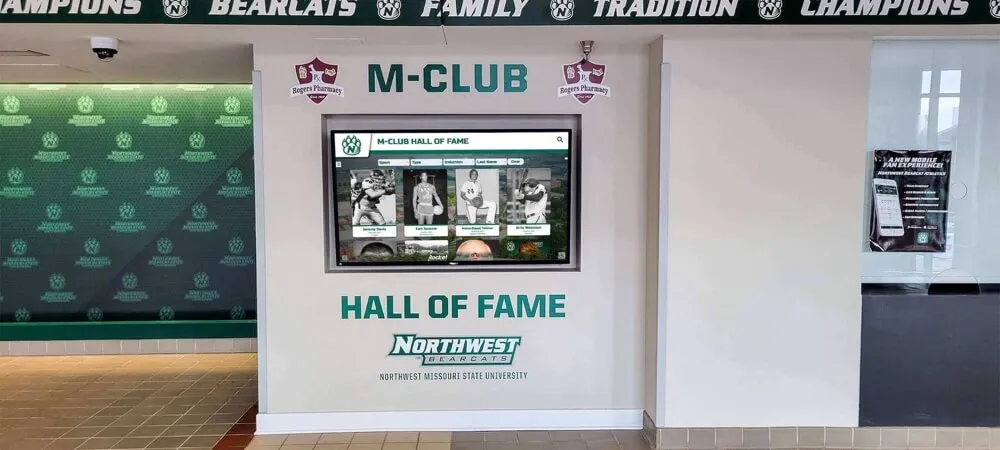
Strategic integration combines digital displays with architectural elements and branding creating cohesive recognition experiences
Addressing Common Concerns About Plaque Digitization
Organizations considering digitization often raise similar questions reflecting understandable concerns about major recognition program changes.
“Will digital recognition feel less permanent than bronze plaques?”
This concern reflects legitimate values about recognition permanence, but analysis shows digital approaches actually provide superior long-term preservation:
Physical plaque vulnerabilities:
- Bronze tarnishes, engraving becomes illegible over decades
- Mounting hardware fails requiring remounting or causing plaque loss
- Building renovations require relocating or removing plaques entirely
- Institutional changes (mergers, name changes, program eliminations) often result in physical plaque removal to storage or disposal
- Fire, flood, or other disasters can destroy physical recognition permanently
Digital permanence advantages:
- Cloud-based storage with geographic redundancy survives local disasters
- Multiple backup layers prevent permanent information loss
- Platform migrations preserve content even as specific technologies evolve
- Digital archives remain accessible regardless of physical building changes
- Deterioration becomes impossible—digital recognition never tarnishes, fades, or becomes illegible
The key is ensuring digital systems use standard formats, maintain redundant backups, and include clear data ownership provisions enabling content preservation even if specific vendors change. Reputable digital recognition platform providers structure services ensuring content permanence exceeds physical plaque durability.
“What happens to our existing physical plaques?”
Organizations handle existing physical recognition through several approaches:
Integrated display maintaining select physical plaques alongside digital systems:
Many organizations choose hybrid approaches displaying most prestigious or historic physical plaques in curated presentations while comprehensive digital systems provide unlimited capacity for complete recognition. This honors tradition while gaining digital advantages.
Archival preservation storing physical plaques in appropriate conditions:
Organizations committed to preserving physical artifacts can photograph plaques comprehensively for digital display while carefully storing originals in climate-controlled archives. This approach maintains physical preservation while solving space limitations through digital access.
Return programs offering plaques to honorees or families:
Some organizations provide physical plaques to original recipients or their families who may value possessing recognition items personally. This transfers ownership while digital archives maintain institutional recognition permanently.
Dignified disposition when physical retention isn’t possible:
Organizations unable to maintain all physical plaques indefinitely sometimes choose respectful disposition after thorough digital documentation. Many metal plaques can be recycled through specialized services. This option remains entirely discretionary based on institutional values and practical constraints.
The essential point is comprehensive digital documentation ensures recognition permanence and accessibility regardless of physical plaque decisions, eliminating forced choices between continued physical storage and recognizing new achievements.
“How do we handle honorees who prefer traditional recognition?”
Some stakeholders, particularly older donors or family members establishing memorials, express preferences for traditional bronze plaques based on familiarity and tangible reassurance.
Education about enhanced digital recognition:
Most concerns diminish when people understand digital recognition advantages:
- Photos and multimedia create richer tributes than text-only plaques
- Web accessibility enables distant family members to view recognition anytime
- Search functionality helps visitors discover their recognition rather than hoping people notice specific plaques among hundreds
- Permanence through redundant cloud backups exceeds physical plaque durability
- Content enhancement over time versus static physical limitation
Demonstration experiences showing actual implementations:
Seeing compelling digital recognition firsthand—experiencing search functionality, viewing multimedia profiles, understanding web access—often converts skeptics who envisioned basic digital signage rather than sophisticated recognition systems.
Hybrid options providing both physical and digital recognition:
Organizations can offer major benefactors choice of physical plaques alongside comprehensive digital profiles, honoring individual preferences while maintaining digital systems enabling unlimited recognition capacity.
Respectful communication acknowledging legitimate preferences:
Some people will always prefer physical recognition based on personal values. Respectful discussion acknowledging these preferences while explaining institutional needs to accommodate growing recognition sustainably typically leads to understanding even among those who might prefer traditional approaches personally.
Most organizations find initial concerns about digital recognition diminish significantly once stakeholders experience actual implementations showing how modern systems enhance rather than diminish recognition quality and permanence.
Measuring Success and Demonstrating Value
Effective digital plaque wall programs include assessment demonstrating value and informing continuous improvement:
Engagement Metrics Showing Increased Interaction
Track quantifiable indicators revealing stakeholder engagement:
Physical display interaction data:
- Daily/monthly interaction counts from touchscreen analytics
- Average session duration per visitor (typically 5-10 minutes for digital vs. 30-60 seconds for physical plaques)
- Content most frequently viewed identifying popular recognition
- Search query patterns revealing discovery interests
- Peak usage times informing content promotion strategies
- Return visitor rates showing sustained interest
Web platform analytics:
- Unique visitor counts and geographic distribution showing reach
- Page views for recognition content
- Time spent on recognition profiles
- Search terms driving organic discovery through search engines
- Social sharing frequency extending recognition through personal networks
- Mobile vs. desktop usage informing responsive design priorities
- Referral sources showing how people discover recognition
These quantitative metrics provide objective evidence about recognition program engagement while identifying optimization opportunities based on actual usage patterns.
Stakeholder Satisfaction Demonstrating Program Value
Complement quantitative data with qualitative feedback:
Honoree and family surveys assessing satisfaction:
- Recognition presentation quality and appropriateness
- Ease of finding their specific recognition
- Comprehensiveness compared to traditional plaques
- Appreciation for multimedia elements and web accessibility
- Likelihood of recommending institutional involvement to others
- Overall satisfaction with recognition experience
Institutional leadership input evaluating strategic value:
- Contribution to institutional advancement goals
- Support for recruitment and engagement initiatives
- Demonstration of values through inclusive recognition
- Return on investment compared to traditional approaches
- Pride in modern, professional recognition programs
Staff and administrator feedback about operational efficiency:
- Time savings from simplified content management
- Reduced administrative burden versus physical plaque coordination
- Ease of responding to information requests
- Quality of platform support and training
- Overall satisfaction with program administration
Visitor observations from general stakeholder populations:
- Unsolicited comments about recognition experiences
- Social media mentions and sentiment
- Word-of-mouth reputation effects
- Comparative feedback versus other institutions’ recognition
- Anecdotal impact stories demonstrating meaningful connections
Institutional Impact Indicators
Monitor broader effects potentially influenced by enhanced recognition:
Alumni engagement outcomes:
- Alumni event attendance trends
- Giving participation rates
- Volunteer involvement levels
- Social media interaction with institutional accounts
- Website traffic to alumni-focused content
- Survey responses about institutional connection strength
Advancement results:
- Donor acquisition trends
- Gift size patterns
- Legacy giving program participation
- Major gift proposal success rates
- Recognition program influence on contribution decisions
- Competitive positioning versus peer institutions
Community relations indicators:
- Prospective student/family impressions during campus visits
- Media coverage of institutional achievements
- Partnership development with community organizations
- General reputation metrics from community surveys
- Regional visibility and institutional prominence
While digital recognition represents just one component of comprehensive stakeholder engagement strategies, strong recognition programs contribute measurably to institutional culture, reputation, and relationship quality across multiple dimensions.
Conclusion: Transforming Recognition for Modern Institutional Needs
Digitizing plaque walls represents more than technological modernization—it fundamentally transforms how organizations recognize contributions, honor achievements, and strengthen stakeholder relationships. Traditional physical plaques served admirably when no alternatives existed, but today’s digital solutions address every limitation of physical approaches while maintaining appropriate dignity and permanence befitting serious institutional recognition.
The compelling advantages are clear: unlimited recognition capacity eliminating space constraints and forced prioritization decisions; instant updates without expensive engraving fabrication; rich multimedia storytelling honoring complete contributions rather than reducing people to name listings; powerful search and discovery enabling personalized exploration; and web accessibility extending recognition reach globally beyond physical wall limitations.
The implementation investment proves manageable, particularly when understanding that traditional approaches generate recurring costs for every new honoree while digital systems provide unlimited capacity after initial setup. Most organizations achieve cost parity within 3-5 years while gaining dramatically superior stakeholder engagement, administrative efficiency, and recognition program quality.
For schools honoring donors who built campuses and programs, recognizing alumni whose achievements inspire current students, celebrating athletic excellence spanning decades, commemorating historic milestones that shaped institutions, or memorializing community members whose contributions deserve lasting tribute—comprehensive digital recognition systems ensure all who merit honor receive appropriate recognition regardless of when contributions occurred or how many others also deserve acknowledgment.
The question isn’t whether digital recognition delivers value—proven benefits across hundreds of implementations demonstrate transformative advantages. The relevant question is when your organization will modernize recognition programs to honor stakeholders appropriately while creating engagement experiences aligned with how people interact with information today.
Organizations committed to meaningful recognition, comprehensive inclusion, engaged stakeholders, and sustainable operations increasingly recognize that digitizing plaque walls represents essential evolution ensuring recognition programs serve institutional values and stakeholder needs effectively for decades to come.
Ready to Digitize Your Plaque Wall?
Discover how comprehensive digital recognition transforms stakeholder engagement while preserving your institutional legacy permanently and accessibly.
Schedule Your Free Digitization ConsultationTransform your plaque wall from space-constrained physical limitation into unlimited digital recognition—creating comprehensive systems that honor every contribution, engage all stakeholders, and ensure your institutional legacy remains accessible and inspiring for generations to come.
